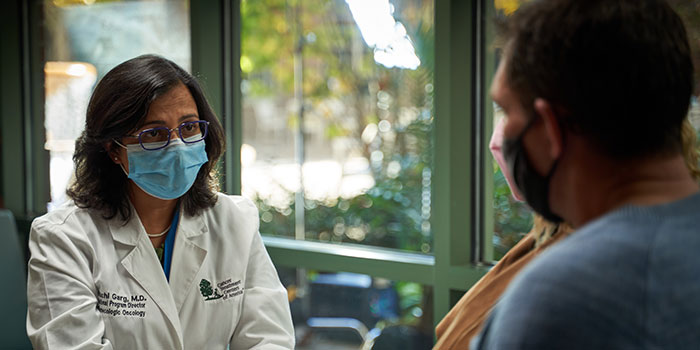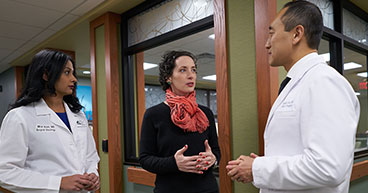
When you’re diagnosed with cancer, you may get a lot of information thrown at you:
- The type of cancer you have
- Its sub-type and stage or grade
- The treatment options available to you
- Which side effects your treatments may cause
As you go through your treatment journey, the information you take in may be different, but it’s often still overwhelming—and potentially confusing.
One example is the terminology your doctor may use after you’ve completed treatment, when cancer has either shrunk or can’t be found by scans or other tests. You may hear that your cancer is in remission, that there’s no evidence of disease, that your surgeon “got all” the cancer, or even that you’re cured or cancer-free.
In this article, we’ll explore:
- What phrases like “cancer remission” and “no evidence of disease” mean
- How oncologists determine which cancer term(s) to use
- When do cancer patients transition to cancer survivors?
- What to know about cancer recurrence
- Survivorship support at City of Hope
If you’ve been diagnosed with cancer and would like to learn more about our treatment options, or if you’re interested in a second opinion on your diagnosis and treatment plan, call us or chat online with a member of our team.
What phrases like 'cancer remission' and 'no evidence of disease' mean
If you’re told your cancer has been “cured,” that your cancer is “in remission” or that have “no evidence of disease,” it’s reason to be optimistic, for sure. But, like many things in life, nuances should be considered.
Some cancers have very high survival rates, especially when caught early. For instance, the five-year survival rate for prostate cancer is nearly 100 percent when the disease is detected and treated early.
Chart: Cancer survival rates by type
The chart below shows the highest overall survival rates for some of the more common cancers, not including skin cancer. New cases and deaths listed are for 2022.
| Cancer | Estimated New Cases | Estimated Deaths | Relative Survival (%) (2012-2018) |
|---|---|---|---|
| Thyroid | 43,800 | 2,230 | 98 |
| Prostate | 268,490 | 34,500 | 97 |
| Testicular | 9,910 | 460 | 95 |
| Melanoma | 99,780 | 7,650 | 94 |
| Breast | 290,560 | 43,780 | 91 |
| Hodgkin Lymphoma | 8,540 | 920 | 90 |
| Uterine | 65,950 | 12,550 | 81 |
| Bladder | 81,180 | 17,100 | 77 |
| Kidney | 79,000 | 13,920 | 77 |
| Non-Hodgkin Lymphoma | 80,470 | 20,250 | 74 |
Source: National Cancer Institute Surveillance, Epidemiology and End Result Program
Other cancers are notoriously resilient and are almost certain to return after treatment. For example, glioblastoma, the most common type of brain cancer, has a nearly 100 percent recurrence rate.
Maurie Markman, MD, President of Medicine & Science at City of Hope Atlanta, Chicago and Phoenix, says it’s important for patients to remember that, as positive as the news is, cancer could come back, even if your doctor doesn’t expect it to, so monitoring for weeks, months and even years afterward is critical to catching cancer early if it does return.
“It’s important to understand what your doctor means when he or she uses these terms,” Dr. Markman says. “If they don’t take a few minutes to explain it to you, you should ask. Telling a patient there’s no evidence of disease should be followed by something like, ‘This is really good news, and we’ll continue to monitor you to make sure it continues.’”
So, what are the subtle differences among the words and phrases doctors may use to describe a successful cancer treatment with a positive outlook?
Cured
When it comes to cancer, “cured” may not always be the most appropriate term to use. That’s because it means that the cancer has gone away with treatment, no more treatment is needed, and the cancer will never come back. It’s rare that a doctor can say with 100 percent certainty that cancer won’t come back. It may be highly unlikely for cancer to return, but it’s possible.
Cancer remission
Often differentiated between “partial” and “complete,” remission refers to a period when cancer is responding to treatment:
In a partial remission, the cancer shrinks but doesn’t go away entirely.
In a complete remission, all symptoms and signs of cancer go away and there’s no detectable cancer in the body—based on scans, blood work and/or other tests, such as a biopsy.
If you are considered in complete remission for more than five years, some doctors may say that you are cured. But that does not mean there may still be undetected cancer cells that may cause a recurrence years later.
During remission, treatment may or may not continue, depending on the type of disease, how fast it grew initially, how advanced it was when doctors first discovered it, its tendency for returning—called recurrence—and the patient’s overall health and treatment goals.
No evidence of disease (NED)
No evidence of disease—often referred to as NED—means exactly that: At present, no signs of disease have been found on any tests.
A subtle difference between complete remission and NED is that NED can be used more broadly. Let’s say a biopsy shows the presence of cancer, but when treatment starts, doctors don’t see any signs of a tumor. In that case, the doctor may say there’s no evidence of disease, not that the cancer is in remission.
While the terms remission and no evidence of disease differ in this way, they share the possibility that some microscopic, undetectable cancer cells remain in the body.
Got all the cancer
While it’s not exactly a medical term, it’s not uncommon for a surgeon to tell you he or she got all the cancer during surgery, but you still may need post-operative chemotherapy or radiation therapy. This is often because, although the surgeon feels confident all traces of cancer were removed, you’ll need to continue treatment to kill remaining cancer cells that may have been left behind.

How oncologists determine which cancer term(s) to use
In many cases, which terminology your oncologist uses comes down to personal preference. Yet the type of cancer you have may dictate which type of surveillance testing is used to monitor you.
Depending on the type of cancer you have, your doctor may use a blood test, biopsy or imaging test like a CT scan—or all of the above—to look for evidence of cancer. For solid tumors like colorectal cancer, for example, the doctor may order a CT scan, while in the case of prostate cancer, a blood test may be used to look for certain proteins or tumor markers. And, in the case of leukemia, lymphoma and other blood cancers, the doctor may order a biopsy of the blood or bone marrow to check for evidence of diseased cells.
When do cancer patients transition to cancer survivors?
If you’ve had clear scans and follow-up tests for five or more years and need fewer or less frequent checkups, some doctors may say you’ve transitioned from surveillance to survivorship. That’s because most cancers that recur do so within the first five years after treatment. In fact, the longer there’s no evidence of cancer, the better the chance it won’t come back.
Still, some cancer patients call themselves survivors from the day of diagnosis, choosing to focus on the positive during and after cancer treatment.
Each cancer patient has the right to determine what cancer survivorship means to him or her. In today’s world, cancer is increasingly a chronic condition that may be managed, and people are living with the disease longer than ever before.
What to know about cancer recurrence
When cancer returns, it’s called a cancer recurrence, which is different from developing a second form of cancer.
The three different types of cancer recurrence are:
Local recurrence, which means the cancer has been found in the same place it was originally diagnosed
Regional recurrence, which means the cancer has resurfaced in lymph nodes or tissue near the original site
Distant recurrence, which means the cancer has been found in tissue in other areas of the body
In general, your risk of cancer recurrence depends on factors like your age and health, your previous treatment, and the type, stage and grade of the original cancer.
No matter where your cancer returns, it keeps the same name, based on where in the body it developed originally. For example, if you had cancer in the breast that recurred in the bones, it’s still considered breast cancer, not bone cancer.
Because of the risk of recurrence, it’s important to stay up to date on follow-up exams, scans and blood tests, and to report any symptoms you experience to your oncologist or care team. No matter how long you’ve gone without a cancer recurrence—even five or 10 years—you still should be on some type of surveillance program.
“I tell my patients, ‘You are not a statistic, a percent, a median. You’re none of those things. You’re an individual,’” Dr. Markman says. “‘While there’s no way for us to know whether cancer will come back, there’s no reason for us to believe that you won’t have a really good outcome. However, we’ll monitor you to make sure that’s the case.’”
Survivorship support at City of Hope
Having cancer can lead to long-term health issues, like chronic pain, fatigue, depression and cognitive issues. At City of Hope, helping patients manage side effects of the disease is a top priority. We recommend screening options, provide interventions for long-term and late effects of cancer and its treatment, coordinate communication between our oncologists and the patient’s primary care provider, and offer guidance about diet, exercise and living a healthy lifestyle.
Having cancer may often feel like you’re on an emotional rollercoaster. No matter where you are in your cancer journey, it’s important to take care of yourself. Whether you just received a diagnosis or just finished treatment, one of the best things you can do is to practice healthy habits, like getting plenty of sleep, eating a healthy diet and exercising.
You can also seek out support groups of people going through their own cancer experiences and keep an open line of communication with your cancer care team. Make sure you stay current on your follow-up visits and keep your doctor updated on how you’re doing and feeling.
If you’ve been diagnosed with cancer and would like to learn more about our treatment options, or if you’re interested in a second opinion on your diagnosis and treatment plan, call us or chat online with a member of our team.


